All Warmed Up: The Early Days of Car Heaters
With much of the United States and Canada recently in the icy grip of a polar vortex, and many regions experiencing sub-zero temperatures (that’s 0 degrees on the Fahrenheit scale, about minus 18 on the Celsius scale for you folks north of the border), it may be an appropriate time for a look into the history of car heaters.
The first motorcars, appropriately termed horseless carriages, were generally open, and like horse-drawn carts and wagons they had no protection from the elements. “Brass era” publications show advertisements for “automotive apparel,” i.e. heavy coats, gloves, and hats, as well as “storm aprons,” essentially ponchos big enough to cover all of the passengers.

You may note that Margaret A. Wilcox was the first to invent a car heater, and that’s true, in a manner of speaking. While she did patent a system that directed air through the engine, heating it, and then routing it to the passenger compartment, the “cars” her 1893 invention warmed were railroad cars, not automobiles. I suppose that conceptually it is the basis for the way early motorcars and later air-cooled automobiles pulled passenger compartment heat from heat exchangers on the exhaust system, but I doubt Ms. Wilcox ever saw an automobile before she filed her patent application. The system did warm railroad passengers, but it was relatively primitive. Without the system they froze; with it, they were roasted.
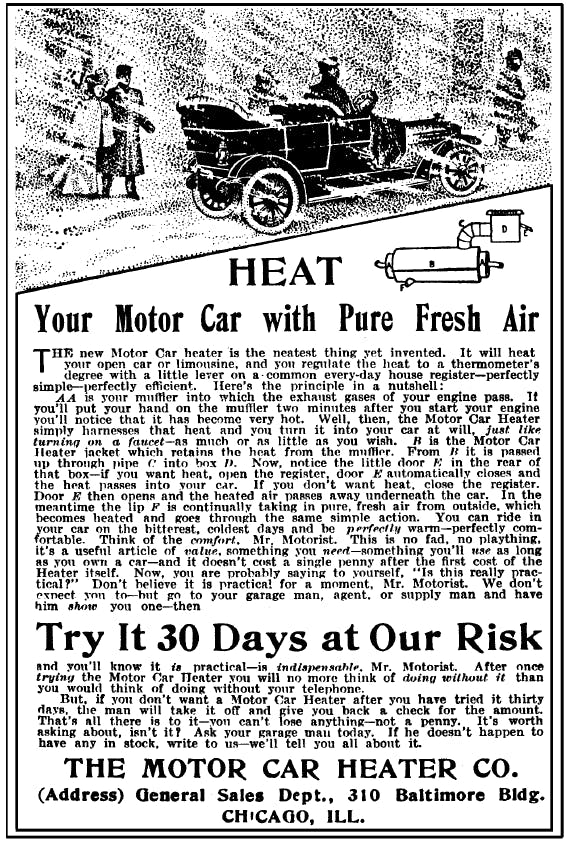
Depending on which source you read, it was either Cadillac in 1906 (or 1907 per some sources) or Hudson in 1913 that first introduced a fully-enclosed automobile. To keep warm, early motorists did what they had done with animal-powered conveyances; they would preheat bricks or soapstone on the oven at home and place them in dedicated hotboxes inside the passenger compartment.
If you think heated steering wheels are a modern accessory, you might be surprised to know that some early electric car builders wrapped heating elements around their steering wheels.

An improvement over hot bricks was the introduction of portable coal-burning heaters, made of galvanized iron with asbestos linings and brass handles for portability. A purpose-manufactured brick of coal (or charcoal) was placed in a drawer in the heater after it was prepared for use in a live fire, presumably a wood- or coal-fired oven at home. After the flame died down, the hot coals were said to burn without odor or smoke. Fortunately, even though automobiles were being enclosed, they weren’t very airtight, so perhaps carbon monoxide from the burning coal wasn’t an issue. One brick was said to be able to heat the passenger compartment for several hours. When heat was no longer needed, the hot coal could be doused with water and reused later.
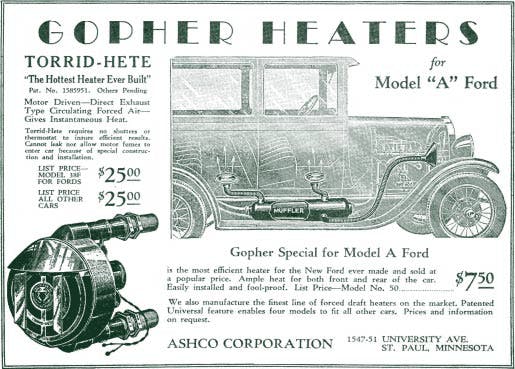
Such portable heaters required preparation ahead of time as well as moving the coals and heaters in and out of the cars. On-board heaters would be much more convenient. Since many early automobiles were air-cooled, attention was given to recovering waste heat from the exhaust system. At least as early as 1907, exhaust gas heaters were sold as automotive accessories. As seen in a period advertisement, one of those designs incorporated a metal jacket around the muffler through which air could be heated and supplied to the passenger compartment via grates in the floor.
In some cases the cabin was heated passively, through convection, and in other cases air was forced through the system, either with an air intake funnel behind the engine fan or actively with an electric blower. A more sophisticated heat exchanger design routed the exhaust gases through bundles of tubes. Heat could be controlled in very rudimentary fashion with valves whose handles were typically mounted on the car floor. Those valves controlled the flow of exhaust gas through the heat exchangers.

As an aftermarket accessory, these early heaters were not very practical. They were hard to retrofit into existing passenger compartments, and sometimes leaked exhaust into the cabin, causing some deaths due to carbon monoxide poisoning. A safer way of using the engine’s waste heat was with manifold heaters, popular with Ford Model A owners. A cast iron duct routed air over the exhaust manifold and into the cabin via a port in the firewall. Enough Model As are still on the road that manifold heaters are still being made, though now they are made of aluminum.
In 1933, after it introduced V-8 power for the masses, Ford developed an in-dash heater for those cars, though it still used exhaust as a heat source. Constructed like steam boiler, hot exhaust was directed into two dozen 13-inch-long flues around which flowed fresh air. The outlet of the heater was installed in the dashboard in front of the passenger. A button at the driver’s feet regulated the heat via an intake valve upstream of the flues.
None of the early exhaust-based heaters had provisions for mixing fresh air with the heated air, so in 1940, Ford had Novi Equipment develop an integrated manifold heater that could mix the heat with fresh air.

Also in the mid-1930s, General Motors’ Delco division developed a clever heating system that duplicated the steam radiators used to heat many homes and buildings. A boiler was located at the outlet of the muffler. The boiler was charged with a very small amount of water, just one ounce, so when the car was started, the heat from the 900°F (482°C) exhaust gases would immediately vaporize that water into steam, causing it to rise into the heater core where an electric fan would blow the heat into the cabin. From the heater core, the steam pipes routed the water vapor through the car’s radiator to condense it back to water.
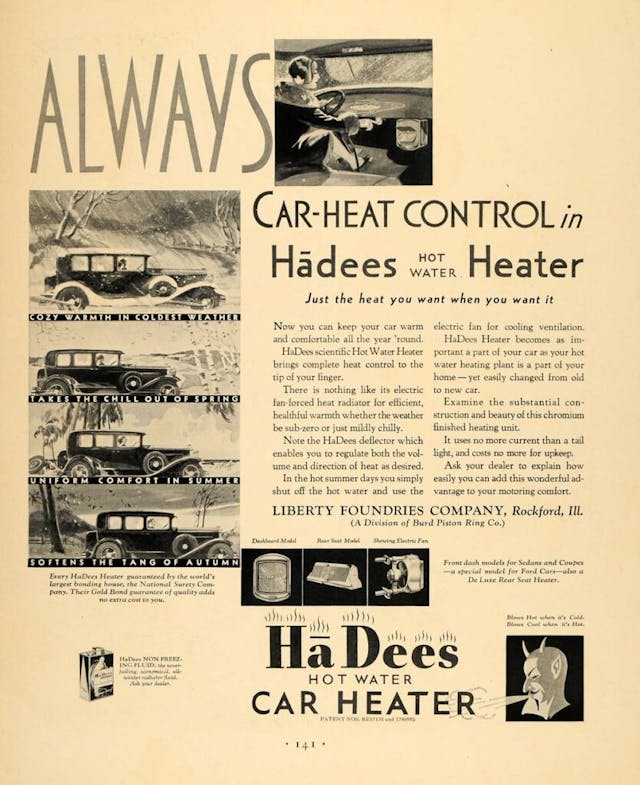
If you are wondering why the auto industry didn’t use the hot water in the cooling systems of water-cooled engines, that’s because exhaust-based heaters could discharge heat at a quite toasty 200°F (93°C) and exhaust gases are hot as soon as you start the engine, unlike engine coolant that has to heat up. However, by the mid 1920s, water pumps and thermostats had gotten reliable enough at regulating engine temperature to allow for hot coolant to be used to heat the passenger compartment. The first coolant-based heaters were aftermarket devices, and it wasn’t unusual for owners to transfer their heaters when they replaced cars.

In the winter of 1927-28, A.B. Arnold fabricated a prototype hot water heater for the Ajax car owned by another Arnold whose initials were also A.B., Arnold B. Modine. Modine had founded Modine Manufacturing in 1916, first making the Spirex-branded radiator for tractors and then supplying Ford with the Turbotube radiator for Model Ts. Incidentally, it was Modine Manufacturing that built the first vehicular wind tunnel in 1941, to test radiators and car heaters.
Modine attributed his success to his insight that the key to managing heat in liquid-cooled engines was focusing on heating the air passing through the radiator, rather than concentrating on lowering the temperature of the coolant. A.B. Arnold took a honeycomb heater core, mounted it under the dashboard and plumbed it into the engine cooling system so that the hot coolant flowed through the core on its way to the radiator, where it would be cooled. The system impressed Modine enough that he started to manufacture it to sell to automakers.
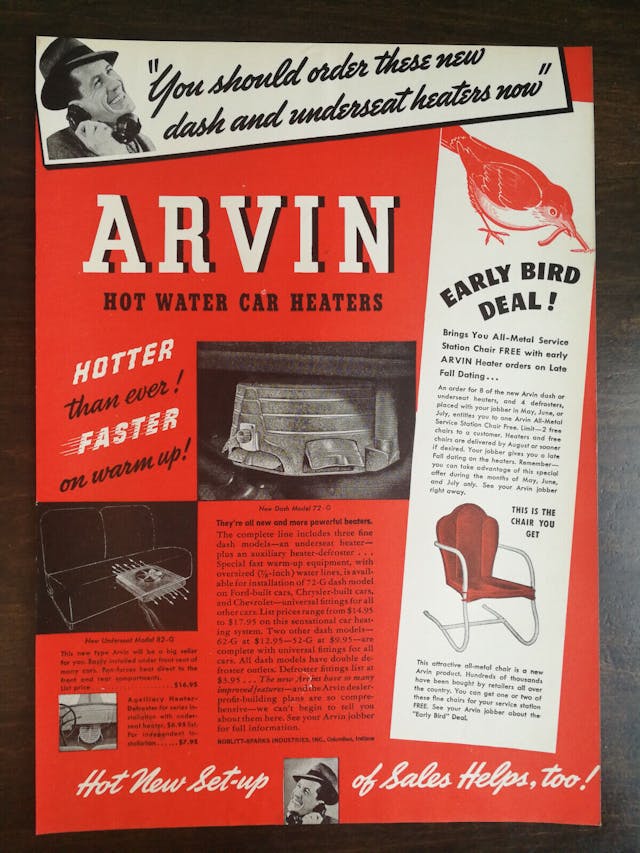
The Trane and Fedders companies, which you may recognize as makers of HVAC equipment, joined Modine in selling hot water-based car heaters, as did brands like Arvin and Ha-Dees (back in the ’30s, it was much more polite to say “hades,” than, “hell”). Major retailers like Sears and Montgomery Ward also sold aftermarket hot-water heaters. As with the Ford manifold heaters, you can buy reproductions for your period-correct restoration.
General Motors got into the picture with coolant-based heaters designed by Carl Darrah at Harrison Radiator Division, and in 1931 they introduced a heater for the rear passengers built into a footrest. Modine introduced a similar footrest design that was one of the first to mix fresh air from outside the car with the heated air. In 1933, A.B. Arnold also addressed the issue of fresh air by ducting heated air from the cowl ventilator on a Ford V-8 to the heater core mounted behind the instrument panel and then routing it from the heater core to the windshield, thereby apparently inventing the defogger.

In 1937, Nash added cabin pressurization to the mix. Filtered air was forced into heater and then to the passenger compartment, creating slightly higher air pressure inside the car. This prevented cold air from seeping in through various routes into the cabin.
It should be noted that with all of those advancements, most automakers did not offer heaters as standard equipment. It wasn’t until 1962 that hot water-based heaters became standard equipment on General Motors cars (well, except for the air-cooled Corvair, which had air forced over heat exchangers built into the exhaust system, similar to air-cooled Volkswagens and Porsches), and it wasn’t until 1968 that automakers stopped making heaters optional equipment. Newly-adopted Motor Vehicle Safety Standards required some kind of heated windshield defrosting system and the only way to do that was making heaters standard.
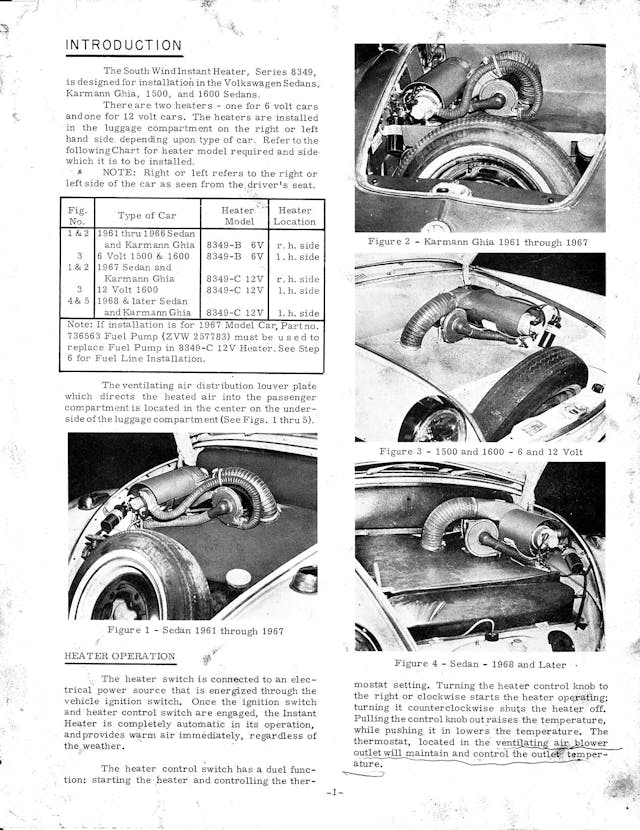
Owners of some of those air-cooled VWs, as well as over-the-road truckers, might be familiar with another heating system. In the late 1930s, the Stewart-Warner company developed a gasoline-burning passenger car heater and in the early ’60s. Working with GM’s Harrison division, they developed a gasoline-fired heater for the Corvair. Essentially a self-contained furnace, it delivered near-instantaneous heat in ample quantities. Stewart-Warner’s Southwind brand advertised them as heating up within 90 seconds. S-W sold them for Volkswagens, as did Germany’s Eberspacher. Nothing will warm the inside of a car faster than a gas-fired heater. Over-the-road truckers have used similar gas-fired heaters to keep their sleeper compartments warm without having to idle their engines for hours.
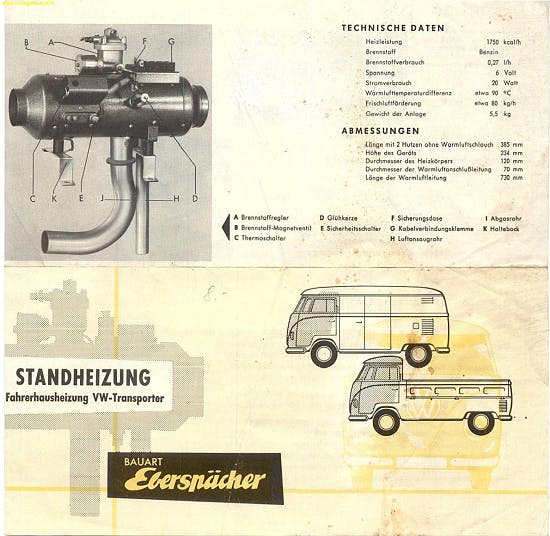
Developments like air conditioning and automatic climate control followed, and perhaps when the weather heats up this summer, we’ll take a look at the history of automotive A/C (short form: Packard, 1939). But in the meantime, if the weather outside is frightful, but inside your car it’s still delightful, you can thank folks like A.B. Arnold, A.B. Moline, Carl Darrah, and maybe even Margaret Wilcox.
***
Check out the Hagerty Media homepage so you don’t miss a single story, or better yet, bookmark it. To get our best stories delivered right to your inbox, subscribe to our newsletters.
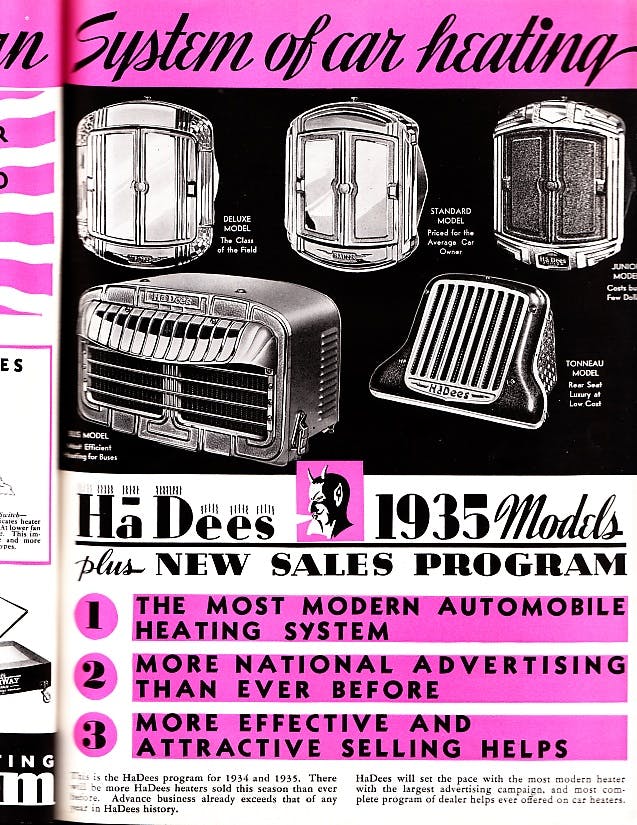


Interesting stuff. I had no idea that in-car heated water heaters weren’t standard in GM cars until 1962 – and I’m not sure I accept it. That would mean that every one of those tri-five Chevys I (and my friends) had in the ’60s were “optioned” cars? They all even had defroster setting on the controls. That seems to be a bit far-fetched to me – especially since more than a few of them started as base six-cylinder cars. I’ve seen MANY tri-five cars with radio delete panels, but don’t remember seeing even ONE without heater box and controls.
My dad’s 60 Impala convertible had neither a heater or A/C. It was a former Hertz rental car based in Florida, so Hertz saved $$ by ordering their Florida cars thus. For a top of the line Impala it was a stripper: hubcaps, rubber floor mats, manual tune am radio, etc.
Florida cars were still getting shortchanged on heat even in the 80s. My wife’s first car was an 88 Cavalier that was a fleet car from Florida and the first 80s car I’d ever seen with an old fashioned fan style rear defroster instead of electric rear defroster that was the norm in New York since the mid 70s.
In the opposite direction the 95 Escort we bought used in Portland Oregon had a factory block heater. My guess is it was originally sold someplace with much colder winters.
I own a 55 Chevy that came with the radio delete panel and had no heater control levers but only one heater fan knob. To change from floor heat to windshield defrost, there is a lever rod under the middle of the dash you access to change the warm air direction. The fan knob was a rheostat type, like a headlight interior switch, to change the fan speed. That’s it.
https://itstillruns.com/facts-s-cars-4963650.html
I guess it depends on what the model years were of those ’60s cars you mentioned. Anything 1962 or later would have had heaters as standard, so only the pre-’62s would have needed to be optioned.
No, it was a delete option. I had a ’63 Comet with no heater, deletion plugs in the dash.
I also pulled a full synchro 3 speed out of a ’65 Merc Monterey that was heater delete.
I had a 1964 VW Karrmann Ghia with a gasoline heater. It was harder on gas than the car engine was. Loved it pretty well tho.
Depends where they were sold. My ’53 Coronet V8, sold in Van Nuys California, shipped with no heater and had an aftermarket heater installed under the driver’s seat when it was brought north in the sixties. ALL canadian cars from the late 30’s on up had the “arctic equipment package” which included a heater and defroster as well as “permanent Antifreeze” and in some cases an electric block heater – and from the sixties up quite often a “rear defogger” – which in many cases just recirculated interior air across the rear windscreen.
I remember “frost sheilds” being very common as well – along with electric defogger panels that stick to the interior of the windscreen on pre-war cars – with a “toaster element” between the glass panel and the windscreen. The frost shield kept moisture from the chilled windscreen glass – which “helped” visibility somewhat
Not sure about GM, but the ’61 and ’62 Econolines came stock with heater blockout panels and the heaters were optional accessories. Other options included a passenger seat and an external lock for the driver’s door. The van was originally designed for use as an urban delivery van, which didn’t need any of that stuff.
Hmmm, I’m beginning to be a bit more accepting. Maybe all of the 1950s cars in my 1960s-1970s experience were originally shipped to Idaho and possibly surrounding states, and thus were always spec’d with heaters (unlike those Florida cars)? Gotta admit, I never bought any tri-five Chevys from down south or even the Southwest!
You would’ve found it hard to do. When I was in high school in Tennessee, the State didn’t salt the roads. Agents would get the local papers as soon as they hit the streets and head out to buy any decent locally advertised cars. They then shipped the cars up to the rust belts and shipped rust buckets from the north back down. If you hit the Knoxville car lots in 1965 looking for a ’55 Chevy, the “eyebrow” over the headlights was always rusted through. That was a good sign that there were other problems you couldn’t see.
The Southwind heater was quite an invention. My Dad swore by the one in his 1939 Ford std. coupe. He had close to 20 of them in his garage when he passed away, most complete units, as well as lots of parts. I sold all of it for 150.00. Nobody seemed interested in them, and information about them seems very hard to find. The idea of having a gasoline fire inside of the car with you keeping you warm made many people feel uneasy.
Southwind also makes heaters for piston twin engine airplanes. I’ve used the testers that block off the combustion air and exhaust and then pressurize the combustion chamber to look for a leak down which would mean a crack. Lots to go wrong. I can only imagine how dangerous a front end collision in a V Dub would be with the gas tank and a red hot heater right there, yikes!
If you hit hard enough to spring a leak in the gas tank of a VW the fire is all but academic at that point. It might be the difference between an open and closed casket, but that’d be it. They’re better than one would think about taking a hit at the front, but that’s a hell of a wallop to get that far in.
My 50s MGA has a water/radiator/fan heater, didnt realize it was cutting edge for the time
MGAs didn’t come out until 1962, fyi.
Oops, my bad, MGB came out in 62, not MGAs. sorry.
Mga were built from 1956 thru 1962, I’ve only seen 1 without a heater. I’ve owned or parted out about 15- 20 of them
I believe it was a ’65 model year, and I was with my Grandfather when he ordered a basic little old lady car for his sister (my Great Aunt). It was a base, white, 2 door Chevy II, red vinyl with no radio, powerglide, power brakes and steering. I do recall an engine option to get an automatic choke! The salesman made a big deal that the heater / defroster was standard! Even as a little kid, this amazed me for a car being sold in Colorado, that heat “could” be an option. In HS, I frequently rode in a VW van that had both manifold bleed air “heating” and the optional gas fired heater. I believe that both systems were better at bringing CO into the cabin, than heat. We dressed warmly, and the shotgun passenger wiped off the windshield fog for the driver.
In HS in Salt Lake City in the early 1970s, my best friend had a late ’60s Bug. The heater controls between the seats never did anything so far as I could tell! We froze all winter.
I’ve driven bugs since I got my license. My dad’s 57 heater would melt the polish on your left shoe, but the rest of you would stay chilly. If you drove through a puddle, it would spray steam on the windshield.
I miss that car!
I have heard tell that VW hot air heaters were actually rather effective — the key was to crack open a window when in use. Supposedly VWs were so well sealed that the cold air inside the interior had no place to escape. (No flow-through ventilation at that time.) And since cold air is heavier than warm, the trapped cold air would settle over the heater outlets, effectively blocking warm air from entering the interior. Therefore, the only heating occurred via heat transfer from the hot air to the stationary cold air.
This info came to me from guy who’d use a brick on the accelerator pedal as a cruise control for his VW van. I can attest it kept the van moving at a constant 60 mph on level ground, engine screaming at max revs the whole time — but never failing. Dude also made a single Karmann-Ghia out of one KG that had been rear ended, and another that had suffered a head-on crash.
And I was with him in Montana when a wheel bearing on that van started making ugly noises. We limped to the nearest junkyard, where he found a wheel bearing from a very old Plymouth that worked well enough to get us to our destination in eastern Oregon.
The man was a legend, and justifiably so.
And I thought the heater in my 1960 MGA was an inefficient British invention!
It was.
The heater in an MGA was optional as well, I think the early MGB’s too.
I remember my Dad had a 1960 Corvair with a gasoline heater. It did the job of heating the car, but fumes were horrible.
The Southwind was the only available heater on all ’60 Corvairs. In ’61 they came with the manifold heater, but the Southwind was an option.
My 50 Mercury convert had a heater. So did my 55 56 57 Chevies as standard. So did my 53 Dodge Red Ram coupe……
1949-1951 Mercurys and Lincolns definitely had heaters and defrosters.
MY DAD WORK FOR A CHEV DEALER THE BEST HAETER AS THE UNDER SEAT HEATER AND A DEFROSTER
An article on heaters and no mention of the Nash Weather Eye. A heater core and a blower motor using the engine’s hot water. It is how every vehicle gets heat today.
Not Teslas! 😉
Don’t run the heater in your Tesla, you might not have enough charge to get home.
I mentioned Nash and their blower motor, just not by the brand name.
A fun article and mostly true. A car buddy has a low mileage 1939 Lincoln Zephyr with a manifold hot air heater. He told me the Zephyr was available with either a hot water or manifold heater when the car was new suggesting the public had not decided which was best back then. Also not ethylene glycol anti-freeze was first introduced in 1926, before that odd mixtures were used, OR you had to drain the water out of the engine when the car sat unused during freezing weather!
BTW — Yes the Corvair had a gasoline powered heater in 1960, but an ad campaign by Ford about poor Corvair winter gas mileage changed that. In 1961 the Corvair had a hot air heater, but you incorrectly noted it was a heat exchange system. It is NOT, it used hot air blown over the cylinders and exhaust manifold and into the passenger compartment! I own a Corvair and yes I keep a small aircraft carbon monoxide warning indicator in the car. One of the things that caused used Corvair values to tank was the “stinky” heater caused by oil leaks on the engine!! Now there is a fix, but back then nobody wanted a “stinky” Corvair. VW and Porsche did eventually use an exhaust manifold heat exchanger on their air cooled engines.
What is the fix? fixing the oil leaks? It seems that any leaks will put an oily odor, or worse, into the heating system.
Oil leaks are almost always at the pushrod tubes, one at the head and the other at the block. Original o-rings were neoprene which could not take the heat of an air-cooled engine. I put Viton o-rings on mine, a simple fix after removing the valve covers. The engine never leaked again even after I threw the belt on the engine, thus losing the engine cooling fan. My car was a Spyder turbo with a head temperature sensor so I knew how hot the motor got.
There were air shutters at the outlet of the cooling shrouds on the rear of the car that had a fluid filled bellows thermostat to control air temperature of the engine. these failed to full open which reduced the available air going to the passenger cabin.
Between the “blue smoke” and tepid at best air coming out of the heater and defroster ducts it was a challenge to drive in the winter in upstate New York.
I had a gasoline heater for the car as well but never installed it. I believe it had a Chevrolet part number on the pieces.
I had a 1964 Porsche 356C with the “gasoline heater.” I never used it for fear of blowing up me and the car ;~)
My grandpa’s 1957 Studebaker Silver Hawk had an auxiliary heater under the front bench. It makes the interior so warmer nicely in frigid weather.
Climatizer, best in the industry — although that Nash Weather Eye was in there swinging. Dad kept a “steam heat” radiator unit from a late-30’s Packard for 40 years, in hope we could plumb it into a tractor cab. It was *only* soldered brass fins on pipe behind the ornate baffles, but the fittings could have been off a marine boiler.